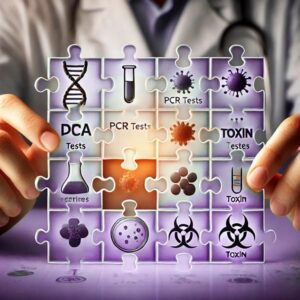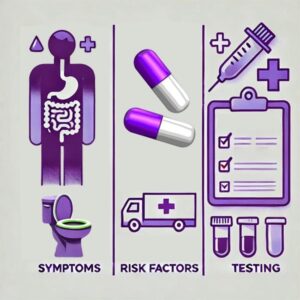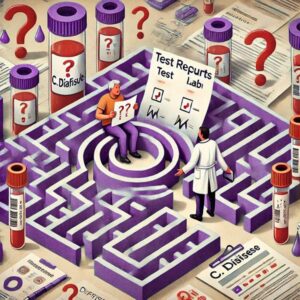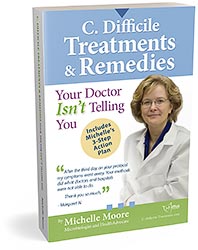 Last updated April 11, 2025
Last updated April 11, 2025
One of the first challenges faced by people with a C. diff. infection is the laboratory testing. C. diff. test results can be difficult to interpret and create a lot of confusion, not only for patients but also for healthcare providers.
In addition, doctors often order the wrong type of test, misdiagnose C. difficile infections, and prescribe incorrect treatments based on misinterpreted results. This is especially common among family doctors and general practitioners who may not have extensive experience treating C. diff. This causes a lot of anxiety and frustration when it comes to getting the correct diagnosis and proper treatment plan.
Why Is Testing So Difficult?
The complexity of C. diff. testing begins with the fact that there are several different types of tests. Each test works in a different way. Some tests look for the presence of C. diff. bacteria, while others search for the toxins these bacteria produce.
Knowing what the test actually measures, selecting the right test and interpreting the results correctly significantly affect the diagnosis.
Another challenge is that no single test is perfect or 100% accurate on its own. Both false positives and false negatives are common. Additionally, you’ll want to avoid excessive testing as it can lead to inaccurate results and misdiagnosis.
C. diff. bacteria can linger in the gut long after an infection has cleared, much like embers glowing after a fire has burned out. Just because a test detects the bacteria doesn’t mean it’s actively causing symptoms. This is why medical experts, including the Association for Professionals in Infection Control and Epidemiology (APIC), discourage repeat testing after an initial negative result.
Here’s my latest video on C. diff testing:
Note: You may be an asymptomatic carrier of C. diff
A further complication arises from the fact that C. difficile is a natural part of many people’s gut microbiome and usually doesn’t cause problems. This means that some people are a carrier (naturally colonized) and are not sick. Also, after a C. diff. infection, it’s common for people to be colonized with C. diff. bacteria, meaning the bacteria are present but not causing symptoms or producing toxins.
Post C. diff infection colonization can persist for months or even years. Therefore, if you are a carrier, some C diff tests may be positive, but that does not necessarily indicate an active infection. C. diff. only causes symptoms if it grows uncontrollably and produces enough toxins.
You need more than test results to properly diagnose
 Lastly, it’s important to remember to keep things in perspective. Test results alone are insufficient to diagnose a C. diff. infection. The best approach includes three key elements:
Lastly, it’s important to remember to keep things in perspective. Test results alone are insufficient to diagnose a C. diff. infection. The best approach includes three key elements:
- A symptom evaluation by your doctor, especially for frequent diarrhea.
- An assessment of risk factors, such as recent antibiotic use, hospital stays, or caring for someone with C. difficile.
- The correct C. diff. test with the Toxin A + B test typically being the most reliable.
A doctor who is knowledgeable and experienced in treating C. diff. can ensure that the right tests are ordered, results are interpreted correctly, and the correct treatment is provided. Doctors more experienced in C. difficile testing and diagnoses are Infectious Disease Doctors and GI Specialists. Just remember that testing alone is usually not enough for an accurate diagnosis; your symptoms and medical history are essential in making the right diagnosis.
Types of C. diff. Tests
The most important test for diagnosing an active C. diff. infection is the toxin test, specifically the Toxin A + B or Toxin B test. Note: This is not the same as a “Toxin Gene” test!
The Toxin A + B or Toxin B tests detect actual C. diff toxins in your gut, which are responsible for the symptoms of a C. diff. infection. However, there are many other types of C. diff. tests used for different purposes, which are explained below.
You may come across acronyms on test reports like “GDH”, “NAAT”, “PCR” or “EIA”. To simplify things there are only two main types of C. diff. tests: colonization and toxin tests. Each of these can have multiple labels, adding to confusion in testing.
Here are the main types of C. diff. tests, along with their pros and cons:
1. EIA Toxin Tests (Toxin A + B or Toxin B Test) – The Gold Standard
These tests check for the actual toxins that make C. diff. so dangerous. If toxins are detected, it indicates C. difficile bacteria are growing, producing toxins and causing infection. This test is a Enzyme Immunoassay (EIA) test. In addition, there is a cytotoxicity culture test (sometimes referred to as a CCNA test) is a cell culture test that also looks for active C. difficile toxin production. Both of these toxin tests are usually included after an initial screening with a GDH or NAAT test.
- Pros: Fast results. Low cost. Detects actual C. diff toxins indicating an active C. diff infection.
- Cons: Low sensitivity cause false negatives, meaning it can miss real infections. Low levels of C. diff toxins or early stage infections can be missed.
- Testing: Toxins break down quickly in stool samples so delays in testing could cause a negative result even if infection is present.
2. GDH (Glutamate Dehydrogenase) Test – A Quick Screening Test
The GDH test simply detects if C. diff bacteria are present or not (colonization). It detects a common enzyme made by all C. diff strains (both toxigenic and non-toxigenic strains of C. diff bacteria). A positive result indicates you are colonized with C. diff bacteria. GDH does not confirm if C. diff bacteria are actually creating toxins (an infection).
- Pros: High sensitivity; rapid and cost-effective.
- Cons: Not specific for active disease (can’t tell if toxins are being produced). If GDH is positive, it requires confirmation with a toxin A + B or Toxin B test to look for actual toxins.
3. NAAT (Nucleic Acid Amplification Test) – Sensitive but Overused
NAAT detects C. difficile Toxin A or B genes (by genetic material), not actual toxins. This is also known as the “Toxin Gene” Test and you may see tcdA and tcdB on the test report. A positive result means C. diff bacteria are present and they have the ability to produce toxins. It does not verify an actual infection exists.
NAAT is best used in combination with the EIA Toxin A + B /Toxin B test to verify toxin production.
- Pros: Rapid results and high sensitivity. Detects colonization.
- Cons: Can’t distinguish between an active infection or colonization. Relatively expensive. Potential for over-diagnosis. If NAAT is positive, it requires confirmation of infection with a toxin A + B or Toxin B test.
- Misdiagnosis Potential: Some doctors inexperienced with C. diff testing may think a positive Toxin A or B gene result means actual toxins are present.
4. Two-Step or Three-Step Algorithms Tests – A Smarter Approach
Many hospitals and labs now use a two-step approach, first screening for C. diff. with GDH and then confirming with a toxin EIA test. This reduces unnecessary treatments while improving accuracy. Combines PCR testing (GDH) with toxin enzyme immunoassay (EIA) Toxin A + B/Toxin B test to confirm active toxin production. NAAT may be used if EIA toxin test is negative.
- Pros: Improved accuracy; More reliable for detecting infection than a single test alone.
- Cons: Requires coordination, longer turnaround time; increased complexity.
Interpreting Results
- GDH –
>> C. diff bacteria are not present. - GDH +
>> C. diff bacteria are present. This means you’re colonized. An infection may or may not be present. - GDH + plus EIA toxin +
>> C. diff bacteria are present (colonized) and they are producing toxins. This means you have an active C. diff infection. - GDH + plus EIA Toxin –
>> A gray area. C. diff bacteria are present (colonized) and you may or may not have a C. diff infection. An experienced doctor with good clinical judgement can help you with evaluation of your symptoms, risk factors and medical history. - GDH + plus EIA Toxin – plus NAAT –
>> C. diff bacteria are present (colonization), no toxins present and no genetic material present indicating C. diff bacteria can produce toxins. This means there is no c. diff infection.
Making Sense of C. diff Testing – What You Can Do
 Dealing with C. diff. is already overwhelming enough without the added confusion of conflicting test results and medical uncertainty. The key takeaway? Testing alone isn’t enough. To get the right diagnosis and the right treatment you need to consider the bigger picture:
Dealing with C. diff. is already overwhelming enough without the added confusion of conflicting test results and medical uncertainty. The key takeaway? Testing alone isn’t enough. To get the right diagnosis and the right treatment you need to consider the bigger picture:
Trust your symptoms. If you’re experiencing persistent diarrhea, cramping, and other classic C. diff. symptoms, these clues are just as important as a test result.
Know your risk factors. If you’ve recently taken antibiotics, been hospitalized, or had C. diff. before, your chances of an active infection increase.
Get the right test at the right time. A single, well-chosen test, especially one that detects toxins, is far more valuable than repeated, unnecessary testing that may lead to misdiagnosis.
Work with a knowledgeable doctor. Not all healthcare providers are equally experienced with C. diff. If your doctor isn’t considering your full clinical picture, don’t hesitate to seek a second opinion.
Why This Matters: The Bigger Picture
Misdiagnosis and overtreatment are two of the biggest challenges in modern C. diff. care. False positives can lead to unnecessary antibiotics, which in turn disrupt your gut microbiome and set the stage for even more infections. On the other hand, false negatives, or relying too heavily on test results alone, can leave real infections untreated, leading to prolonged illness and higher risks of complications.
Finding the right balance means being informed, asking the right questions, and taking an active role in your healthcare. You are your own best advocate.
What Comes Next? Choosing the Right Treatment Path
Even with the best testing approach, the real challenge comes next: figuring out what to do about it. Mainstream treatments for C. diff., like antibiotics, can sometimes help—but they also come with serious downsides, including high relapse rates and further damage to your gut microbiome.
That’s why it’s important to understand all of your options, including the pros, cons, and pitfalls of conventional treatments. We’ve put together a comprehensive guide to help you navigate the mainstream treatment landscape and make informed decisions about your health.
➡️ Click here to explore the pros and cons of mainstream C. diff. treatments:
Don’t let confusing test results and conflicting advice leave you stuck. Arm yourself with knowledge, ask the right questions, and take control of your recovery.

About the Author – Michelle Moore, BSc
Michelle Moore is a microbiologist, holistic health educator, and author of C. difficile Treatments & Remedies. With over 10 years of experience in pharmaceutical research and over 20 years in natural medicine, she helps people overcome C. difficile and other chronic infections naturally.
References
- Centers for Disease Control and Prevention (CDC). “Clinical Testing and Diagnosis for CDI.” March 6, 2024. https://www.cdc.gov/c-diff/hcp/diagnosis-testing/index.html
- Mayo Clinic. “C. difficile infection – Diagnosis and treatment.” September 1, 2023. https://www.mayoclinic.org/diseases-conditions/c-difficile/diagnosis-treatment/drc-20351697
- Centers for Disease Control and Prevention (CDC). “C. diff: Facts for Clinicians.” January 17, 2024. https://www.cdc.gov/c-diff/hcp/clinical-overview/index.html
- Mayo Clinic. “Pseudomembranous colitis – Diagnosis & treatment.” September 1, 2023. https://www.mayoclinic.org/diseases-conditions/pseudomembranous-colitis/diagnosis-treatment/drc-20351439
- Centers for Disease Control and Prevention (CDC). “Clinical Guidance for C. diff Prevention in Acute Care Facilities.” March 8, 2024. https://www.cdc.gov/c-diff/hcp/clinical-guidance/index.html
- Mayo Clinic. “Antibiotic-associated diarrhea – Diagnosis & treatment.” https://www.mayoclinic.org/diseases-conditions/antibiotic-associated-diarrhea/diagnosis-treatment/drc-20352237
- Centers for Disease Control and Prevention (CDC). “About C. diff.” December 18, 2024. https://www.cdc.gov/c-diff/about/index.html


 Fill in the form below to get our C. diff. tips newsletter and your free report “10 Things You Need to Know to Overcome C. difficile”.
We value your Privacy. Your email will be kept strictly confidential & secured. See our
Fill in the form below to get our C. diff. tips newsletter and your free report “10 Things You Need to Know to Overcome C. difficile”.
We value your Privacy. Your email will be kept strictly confidential & secured. See our 
